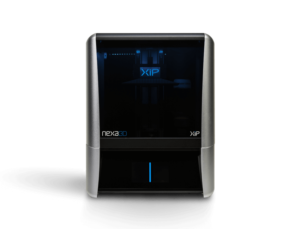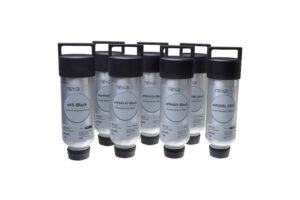- Xometry Joins QLS 820 Manufacturing Partner Network - March 22, 2023
- Weerg Offers Quick-Turn Resin 3D Printing Service by Installing Four NXE 400Pro Printers - March 22, 2023
- Nexa3D Acquires XYZ Printing’s SLS Technology - March 19, 2023
 We’re extremely excited about the newly released XiP Desktop 3D Printer. We hope, of course, that you’re excited, too – but we realize that you may be asking yourself “Why does the 3D printing world need another desktop resin printer?”
We’re extremely excited about the newly released XiP Desktop 3D Printer. We hope, of course, that you’re excited, too – but we realize that you may be asking yourself “Why does the 3D printing world need another desktop resin printer?”
We understand your concerns – so allow us to illuminate.
The XiP isn’t “just another” desktop resin 3D printer, for a number of reasons. Chief among them is the 3D printing technology it uses. Like our industrial 3D printers, the NXE 400 and dental-specific NXD 200, the XiP features Nexa3D’s proprietary Lubricant Sublayer Photocuring, or LSPc, technology.
So…what exactly does that mean?
Resin 3D Printing
Resin 3D printing technology typically falls into one of three main categories:
- Stereolithography (SLA) – first generation
- Digital Light Processing (DLP) – second generation
- Masked Stereolithography (mSLA) – third generation
LSPc is a type of mSLA technology, in many ways a next generation of this process. Like traditional SLA printing, mSLA cures resin material by exposing it to ultraviolet light, but instead of tracing each layer with a laser beam, it uses a larger area UV light source that is “masked” with an LCD screen. This allows the patterned light to expose the resin consistently and simultaneously across the curing plane – think micro-patterned flood-lamp rather than tracing with a pencil-like beam. This makes mSLA much faster than traditional SLA.
LSPc is even faster still.
Like other 3D printing technologies, resin 3D printing works by adding material one layer at a time. Those layers, and definitely fine features, can be quite fragile when they’re added. Since desktop SLA printers are “inverted”, meaning they print upside down, they cure against a vat bottom or vat membrane. Care must be taken to peel the part away from the vat to protect the fine structure. This process, known as the peel, is often done using a slow and delicate operation.
Nexa3D, however, developed a self-lubricated, flexible membrane that resists sticking to the both the printed part and the underlying LCD screen, which allows much faster – some might even say ultrafast! – printing speeds.
Since we’ve touched on SLA a little bit already, let’s shift our focus to DLP. This uses a UV lamp source shone onto a Digital Light Processing (DLP) chip and an optical system to expose the resin in the print area. Based on the focal length of the system, the light spreads out over the curing plane, resulting in differing resolution at the edges of the build area as compared to the center.
In contrast, LSPc uses a UV light array combined with the LCD mask to uniformly expose the entire build area, resulting in evenly detailed prints.The pitch of the 9.3” 4K LCD screen used in LSPc technology is 52 microns. And at this size, a XiP pixel is already a fraction of the laser-spot size of other desktop SLA printers.
As pixel sizes decrease further, surface quality will improve. However, mSLA slices are really just gray-scale images. Using image processing techniques, such as anti-aliasing, the LCD mask can soften edges and linearize curvatures between layers. The result is sub-pixel resolutions and an unexpectedly excellent surface finish.
Another virtue of an LCD screen is that the pixels never move – neither relative to their neighboring pixels nor to the z-axis. And because they are positioned immediately before the curing plane, any aberrant light has negligible effect on the part. These smart choices ensure resin cures where it was meant to, giving the XiP exceptional accuracy.
If you want to see for yourself how this all works, check out this recent video from Joel Telling, best known as the 3D Printing Nerd. In it, he builds a XiP right at our HQ and discusses the various elements that have gone into making it such a unique printer:
XiP User Experience
So, yes, the XiP is fast. And precise. What else? For one thing, it’s easy to use.
We believe you should not need to be a 3D printing expert in order to use a 3D printer. The XiP is designed to be user-friendly for everyone, whether you’re a dentist who has never 3D printed before and wants to print some trays or retainers, or a seasoned 3D printing professional looking for a high-speed upgrade.
Materials
One of these user-friendly features is the Smart Resin System.
Our no-mess, easy-to-use resin cartridges allow users to quickly load and unload material, even during a live print job. Just pop the cartridge in, secure it, and the XiP will automatically begin resin authentication and compatibility checks with the current build requirements using NFC technology.
Want to see for yourself how easy it is? Joel Telling can help you out again – this time from Formnext 2021, where he joined us to take a first look at the features of the XiP.
Modular Design
The XiP also has a fully modular design, which means that you can easily repair or replace parts yourself, rather than having to send your printer off for days or weeks to a repair center. You likely won’t have to make repairs or replacements very often, though, as the XiP is built to be tough and long-lasting, even with frequent use.
It’s a “lights-out” design, too, meaning that you can start a print and walk away, get a coffee, even go to bed for the night, without worrying about having to constantly monitor the print job. The XiP’s got this.
Open Materials

We’ll talk more about materials in a future blog post as well, but let’s just touch on the XiP’s open material platform. You can use our resins and those validated from our partners (which are pretty great), but you can also use other resins or even develop your own resins.
Naturally, given an NFC system in place, there’s some nuance to how that all works in practical terms. That comes into play with the software package you choose to go with your XiP, from ready-to-go with tuned profiles for validated materials to R&D-ready to dial in your own materials. We’re all about encouraging innovation from every 3D printer user.
Sustainability from the Start
Finally, I would be remiss if I didn’t bring up the sustainable design of the XiP. At Nexa3D, we are serious about minimizing environmental impact.
As we’ve mentioned, the XiP is built to last. But eventually, if your printer needs to be retired, you can recycle its all-aluminum body easily. Aluminum is among the most-recycled materials in the world, and it can be recycled anywhere, so once again shipping is minimized. Additionally, the material canisters are also made out of aluminum. And for every XiP sold, we are committed to planting 10 trees to help reforestation efforts in parts of the world that need it the most. Shoutout to ForestNation for helping us with this important effort!

